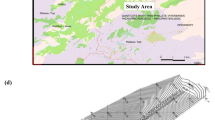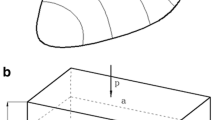Abstract
Shallow landslides have posed significant threats to humans around the world. In order to reduce landslide disaster risk, the effectiveness of early warning systems and hazard zonation work needs to be improved. This research attempted to couple a landslide simulation model (LS-RAPID model) and a hydrological model (Rainfall-Runoff-Inundation (RRI) model) to exploit the advantages of each model for simulating and predicting landslide hazard (location and timing). The pilot area is a small catchment where a shallow landslide happened in July 2015 after 2 days of heavy rain. The landslide buried 3 houses and killed 8 people in Cao Thang Ward, Halong City, Vietnam. A soil sample was collected from the sliding surface and tested using an undrained ring-shear apparatus ICL-2 in the undrained condition. A thickness map of the potential sliding material was interpolated from the relationship between the depth of sandy soil layer and slope (based on 12 soil drill locations) and updated through field surveys in the study area. Different pore water pressure ratio scenarios were applied in the LS-RAPID model to simulate in 3D the initiation and motion of the rapid shallow landslide to create different hazard maps. The subsurface water level was monitored at two locations on the top of the shallow landslide. Based on the observed subsurface water and rainfall data, the RRI model was calibrated and then integrated with the LS-RAPID scenarios to generate Risk Index maps. The simulation results from the newly proposed coupled hydrological-geotechnical framework were compared with those from the observed landslide hazard and showed the reliability to predict the spatial and temporal occurrence of landslide hazard. This could be very useful for supporting decision-makers in rainfall-induced landslide hazard early warning and land use planning.















Similar content being viewed by others
References
An H, Tran TV, Lee G, Kim Y, Kim M, Noh S, Noh J (2016) Development of time-variant landslide-prediction software considering three-dimensional subsurface unsaturated flow. Environ Model Softw 85:172–183. https://doi.org/10.1016/j.envsoft.2016.08.009
Begueria S, Van Asch TWJ, Malet JP, Grondahl S (2009) A GIS-based numerical model for simulating the kinematics of mud and debris flows over complex terrain. Nat Hazards Earth Syst Sci 9:1897–1909. https://doi.org/10.5194/nhess-9-1897-2009
Bogaard T, Greco R (2014) Preface: “hillslope hydrological modelling for landslides prediction”. Hydrol Earth Syst Sci 18:4185–4188. https://doi.org/10.5194/hess-18-4185-2014
Brabb EE (1991) The world landslide problem. Episodes 14(1):52–61. https://doi.org/10.18814/epiiugs/1991/v14i1/008
Chen JH, Lee CF (2007) Landslide mobility analysis using MADflow. International Forum on Landslide Disaster Management, 2007, Hong Kong, China, vol 2, pp 857–874
Crosta GB, Frattini P (2003) Distributed modelling of shallow landslides triggered by intense rainfall. Nat Hazards Earth Syst Sci 3:81–93. https://doi.org/10.5194/nhess-3-81-2003
Dai FC, Lee CF, Ngai YY (2002) Landslide risk assessment and management: an overview. Eng Geol 64(1):65–87. https://doi.org/10.1016/S0013-7952(01)00093-X
Dang K, Sassa K, Konagai K, Karunawarden A, Bandara RMS, Hirota K, Tan Q, Ha ND (2019) Recent rainfall-induced rapid and long-traveling landslide on 17 May 2016 in Aranayaka, Kegalle District, Sri Lanka. Landslides 16(1):155–164. https://doi.org/10.1007/s10346-018-1089-7
Das BM (2019) Advanced soil mechanics. Taylor and Francis. Fifth edition. ISBN: 9781351215183
Das BM, Sobhan K (2018) Principles of geotechnical engineering. Cengage Learning. Ninth edition. ISBN: 978-1-305-97093-9
DOC (2016) Report on the migration plan to mitigate landslide and flood disasters for Quang Ninh province from 2016 to 2020 with orientations to 2025. Department of Construction, Quang Ninh Provincial People’s Committee, Socialist Republic of Vietnam (In Vietnamese)
Endreny TA (2006) Land use and land cover effects on runoff processes: urban and suburban development. In: Anderson MG, JJ MD (eds) Encyclopedia of hydrological sciences. https://doi.org/10.1002/0470848944.hsa122
Engman ET (1986) Roughness coefficients for routing surface runoff. J Irrig Drain Eng 112(1):39–53. https://doi.org/10.1061/(ASCE)0733-9437(1986)112:1(39)
Formetta G, Rago V, Capparelli G, Rigon R, Muto F, Versace P (2014) Integrated physically based system for modeling landslide susceptibility. Procedia Earth and Planetary Science 9:74–82. https://doi.org/10.1016/j.proeps.2014.06.006
He X, Hong Y, Vergara H, Zhang K, Kirstetter PE, Gourley JJ, Zhang Y, Qiao G, Liu C (2016) Development of a coupled hydrological-geotechnical framework for rainfall-induced landslides prediction. J Hydrol 543(B):395–405. https://doi.org/10.1016/j.jhydrol.2016.10.016
Hungr O (2009) Numerical modelling of the motion of rapid, flow-like landslides for hazard assessment. KSCE J Civ Eng 13(4):281–287. https://doi.org/10.1007/s12205-009-0281-7
Kjekstad O, Highland L (2009) Economic and social impacts of landslides. In: Sassa K, Canuti P (eds) Landslides-disaster risk reduction. Springer, Berlin, pp 573–587
Lepore C, Arnone E, Noto LV, Sivandran G, Bras RL (2013) Physically based modeling of rainfall-triggered landslides: a case study in the Luquillo forest, Puerto Rico. Hydrol Earth Syst Sci 17:3371–3387. https://doi.org/10.5194/hess-17-3371-2013
Liao Z, Hong Y, Wang J, Fukuoka H, Sassa K, Karnawati D, Fathani F (2010) Prototyping an experimental early warning system for rainfall induced landslides in Indonesia using satellite remote sensing and geospatial datasets. Landslides 7(3):317–324. https://doi.org/10.1007/s10346-010-0219-7
Liu KF, Huang MC (2006) Numerical simulation of debris flow with application on hazard area mapping. Comput Geosci 10:221–240
Loi DH, Lam HQ, Sassa K, Takara K, Dang K, Thanh NK, Tien PV (2017) The 28 July 2015 rapid landslide at Ha Long city, Quang Ninh, Vietnam. Landslides 14(3):1207–1215. https://doi.org/10.1007/s10346-017-0814-y
Mizutori M (2018) SRSG statement for the international landslide consortium conference Kyoto, Japan. In: Sassa K, Dang K (eds) Proceedings of 2018 IPL symposium on landslides, 03 December 2018. Kyoto University, Uji Campus, Kyoto
Okada Y, Sassa K, Fukuoka H (2000) Liquefaction and the steady state of weathered granitic sands obtained by undrained ring shear tests: a fundamental study of the mechanism of liquidized landslides. Journal of Natural Disaster Science 22(2):75–85. https://doi.org/10.2328/jnds.22.75
Penna D, Borga M, Aronica GT, Brigandì G, Tarolli P (2014) The influence of grid resolution on the prediction of natural and road-related shallow landslides. Hydrol Earth Syst Sci 18:2127–2139. https://doi.org/10.5194/hess-18-2127-2014
Petley DN (2008) The global occurrence of fatal landslides in 2007. Geophysical Research Abstracts Vol. 10, EGU2008–A–10487, EGU General Assembly 2008
Petley D (2012) Global patterns of loss of life from landslides. Geology 40(10):927–930. https://doi.org/10.1130/G33217.1
Petley D, Dunning S, Rosser NJ (2005) The analysis of global landslide risk through the creation of a database of worldwide landslide fatalities. In: Hungr O, Fell R, Couture R, Eberhardt E (eds) Landslide risk management, pp 367–374
Rossi G, Catani F, Leoni L, Segoni S, Tofani V (2013) HIRESSS: a physically based slope stability simulator for HPC applications. Nat Hazards Earth Syst Sci 13:151–166. https://doi.org/10.5194/nhess-13-151-2013
Salciarini D, Godt JW, Savage WZ, Conversini P, Baum RL, Michael JA (2006) Modeling regional initiation of rainfall-induced shallow landslides in the eastern Umbria Region of Central Italy. Landslides 3(3):181–194. https://doi.org/10.1007/s10346-006-0037-0
Sassa K, Fukuoka H, Wang G, Ishikawa N (2004) Undrained dynamic-loading ring-shear apparatus and its application to landslide dynamics. Landslides 1(1):7–19. https://doi.org/10.1007/s10346-003-0004-y
Sassa K, Nagai O, Solidum R, Yamazaki Y, Ohta H (2010) An integrated model simulating the initiation and motion of earthquake and rain induced rapid landslides and its application to the 2006 Leyte landslide. Landslides 7(3):219–236. https://doi.org/10.1007/s10346-010-0230-z
Saulnier GM, Beven K, Obled C (1997) Including spatially variable effective soil depths in TOPMODEL. J Hydrol 202:158–172. https://doi.org/10.1016/S0022-1694(97)00059-0
Sayama T, Ozawa G, Kawakami T, Nabesaka S, Fukami K (2012) Rainfall-runoff-inundation analysis of the 2010 Pakistan flood in the Kabul River basin. Hydrol Sci J 57(2):298–312. https://doi.org/10.1080/02626667.2011.644245
Sayama T, Tatebe Y, Tanaka S (2017) An emergency response-type rainfall-runoff-inundation simulation for 2011 Thailand floods. J Flood Risk Manag 10(1):65–78. https://doi.org/10.1111/jfr3.12147
Schiliro L, Montrasio L, Scarascia Mugnozza G (2016) Prediction of shallow landslide occurrence: validation of a physically-based approach through a real case study. Sci Total Environ 569–570:134–144. https://doi.org/10.1016/j.scitotenv.2016.06.124
Schuster RL, Highland LM (2001) Socioeconomic and environmental impacts of landslides in the Western Hemisphere. U.S. Dept. of the Interior, U.S. Geological Survey. https://doi.org/10.3133/ofr01276
Takasao T, Shiiba M (1988) Incorporation of the effect of concentration of flow into the kinematic wave equations and its applications to runoff system lumping. J Hydrol 102:301–322
Tao J, Barros AP (2014) Coupled prediction of flood response and debris flow initiation during warm- and cold-season events in the southern Appalachians, USA. Hydrol Earth Syst Sci 18:367–388. https://doi.org/10.5194/hess-18-367-2014
Tran TV, Alvioli M, Lee G, An HU (2018) Three-dimensional, time-dependent modeling of rainfall-induced landslides over a digital landscape: a case study. Landslides 15(6):1071–1084. https://doi.org/10.1007/s10346-017-0931-7
Van Westen CJ, Terlien MJT (1996) An approach towards deterministic landslide hazard analysis in GIS. A case study from Manizales (Colombia). Earth Surf Process Landf 21:853–868. https://doi.org/10.1002/(SICI)1096-9837(199609)21:9<853::AID-ESP676>3.0.CO;2-C
Vivoda M, Dugonjić Jovančević S, Arbanas Ž (2014) Landslide occurrence prediction in the Rječina River Valley as a base for an early warning system. In: Proceedings of the 3rd Croatian-Japanese Project Workshop and 1st Regional Symposium on Landslides in the Adriatic-Balkan Region ‘Landslide and Flood Hazard Assessment’, 6–9 March 2013. Zagreb, Croatia
Weiler M, McDonnell JJ, Tromp-van Meerveld I, Uchida T (2006) Subsurface stormflow. In: Anderson MG, JJ MD (eds) Encyclopedia of hydrological sciences. https://doi.org/10.1002/0470848944.hsa119
Zhang K, Xue X, Hong Y, Gourley JJ, Lu N, Wan Z, Hong Z, Wooten R (2016) iCRESTRIGRS: a coupled modeling system for cascading flood–landslide disaster forecasting. Hydrol Earth Syst Sci 20:5035–5048. https://doi.org/10.5194/hess-20-5035-2016
Acknowledgments
The authors are immensely grateful to Dr. Le Quoc Hung (Northwestern Geological Division—General Department of Geology and Minerals of Vietnam, MONRE); colleagues from Vietnam Institute of Geosciences and Mineral Resources, MONRE; and Dr. Tran The Viet (Thuy Loi University) for their support and valuable comments on this study. Special thanks go to the Vietnam Institute of Transport Science and Technology for their support of the field investigation and soil sample collection. The authors are grateful to the two anonymous reviewers for their insightful comments and suggestions that improved this paper.
Funding
This work is a part of the State-Funded Landslide Project (SFLP) “Investigation, assessment and warning zonation for landslides in the mountainous regions of Vietnam.” The research was also financially supported by the Ministry of Education, Culture, Sports, Science and Technology of Japan (MEXT) and the Japan-ASEAN Science, Technology and Innovation Platform (JASTIP). This research contributes to the Sendai Landslide Partnerships (former ISDR-ICL Sendai Partnerships) 2015–2025 in which Deputy Minister Nguyen Linh Ngoc of the Ministry of Natural Resources and Environment of the Socialist Republic of Vietnam (MONRE) signed on 31 May 2017 during the Fourth World Landslide Forum. The Vietnam Institute of Geosciences and Mineral Resources (VIGMR), MONRE, has joined the partnership on 16 March 2015 as a member of the International Consortium on Landslides.
Author information
Authors and Affiliations
Corresponding author
Rights and permissions
About this article
Cite this article
Ha, N.D., Sayama, T., Sassa, K. et al. A coupled hydrological-geotechnical framework for forecasting shallow landslide hazard—a case study in Halong City, Vietnam. Landslides 17, 1619–1634 (2020). https://doi.org/10.1007/s10346-020-01385-8
Received:
Accepted:
Published:
Issue Date:
DOI: https://doi.org/10.1007/s10346-020-01385-8




